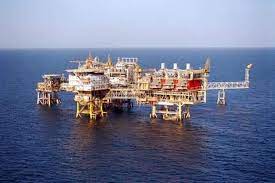
Krishna-Godavari Basin:Crude Oil Production
Krishna-Godavari Basin:Crude Oil Production
GS-1: Geography
(Natural resources in India)
(UPSC/State PSC)
Jan. 13, 2024
Why in News:
Recently, Oil and Natural Gas Corporation (ONGC)commenced 'first crude oil production' from a deepsea water block (KG-DWN-98/2 block) in the Krishna Godavari Basin.
- The project is expected to increase ONGC's total oil and gas production by 11 percent and 15 percent respectively.
- India's current production of oil and natural gas is expected to increase by 7 percent each.
About KG-DWN-98/2 Project:
- KG-DWN-98/2 or KG-D5 block sits next to Reliance Industries’ KG-D6 block in the KG basin.
- It is situated around 35 km from the coast of Andhra Pradesh, Godavari river delta in water depths of 300-3,200 meters in the Bay of Bengal.
- For this project, ONGC employed a cluster development approach, in which oil discoveries were divided into three groups.
Significance of KG-DWN-98/2:
- Large projects like KG-DWN-98/2 are critical to the country’s objective of reducing its reliance on oil and gas imports to meet its rapidly growing energy needs.
- India is the world’s third-largest consumer of crude oil and depends on imports to meet over 85 percent of its requirement.
- The country is also a major importer of natural gas, as domestic gas output is able to meet around 50 per cent of the demand.
About Offshore Drilling:
- Offshore drilling refers to the process of extracting oil and natural gas from beneath the seabed. This activity involves drilling wells in the seabed and is typically conducted in continental shelves.
Its significance:
- Offshore drilling holds significance for India in several ways, contributing to the country’s energy security, economic development, and technological advancement.
About Krishna-Godavari basin:
- The Krishna-Godavari basin is a sedimentary passive margin pericratonic (comprises fluvial, lacustrine and paludal sediments and is characterized by plant fossils) basin located on the east coast of India.
- The basin came into existence following rifting along the eastern continental margin of Indian Craton in early Mesozoic.
- The basin is bounded by the Eastern Ghats to the east and the Deccan Traps to the west.
- The basin is divided into two sub-basins: the Krishna sub-basin and the Godavari sub-basin.
- Hydrocarbon Potential: The Krishna Godavari Basin is an established hydrocarbon province with a resource base of 1130 MMT, of which 555 MMT is appraised for the offshore field.
- Deposition systems: Godavari delta system, Masulipatnam shelf-slope system, Nizampatinam shelf-slope system and Krishna delta system.
Its Significance
- The Krishna-Godavari basin is an important economic asset for India. The basin provides a significant source of energy, minerals, and other natural resources for the country.
- The basin is also a major source of employment for the region.
- It is one of the most important hydrocarbon-producing basins in India, accounting for about 20% of the country’s oil and gas production. The oil and gas produced in the basin is found in the sandstone and shale formations.
- The Krishna-Godavari basin is also home to a number of other natural resources, including iron ore, which is mined in the region.
- The basin also has a number of limestone deposits, which are used in the construction industry.
About Indian Oil Natural Gas Corporation (ONGC):
- ONGC was established on 14 August 1956 as the Oil and Natural Gas Commission by the Government of India. In 1994 the Oil and Natural Gas Commission was converted into a corporation and in 1997 it was recognized as one of the Navratnas by the Government of India. After this, in the year 2010 it was given the status of Maharatna company.
- At present, this company contributes about 71 percent to the Indian domestic production.
Current scenario of India's oil imports and consumption:
- India is the world's third largest oil consumer after America and China.
- Currently, oil consumption in India is about 5 million barrels per day and the demand for oil is growing at the rate of 3-4 percent annually.
- India may consume about 7 million barrels per day in the coming decade.
- According to the Petroleum Planning and Analysis Cell (PPAC), India imported 212.2 million tones of crude oil in 2021-22, up from 196.5 million tones in the previous year.
- Oil import dependence was about 86.4% in April 2022-23, which was 85.9% in the same period a year ago.
Initiatives to reduce crude oil imports in India:
- Urja Sangam 2015: India's largest global hydrocarbon initiative launched in March 2015 with the aim of shaping energy security to reduce import dependence from 77 percent to 67 percent by 2022 and 50 percent by 2030.
- Ethanol Blending Program (EBP):The Government of India has launched the Ethanol Blending Program (EBP) with the aim of reducing the country's dependence on crude oil imports, cutting carbon emissions and increasing farmers' income.
- The government has decided to achieve the target of blending 20% ethanol (also known as E20) in petrol by 2025, well before the year 2030.
Conclusion:
Domestic production should be encouraged to meet the growing demands of oil in India and strengthen the oil economy. However, public sector oil major Oil and Natural Gas Corporation (ONGC) is also taking various steps to increase production through redevelopment of existing mature oil fields and development of new/marginal fields.
Source: The Statesman
--------------------------------------
Mains Question:
Mention the role of Oil and Natural Gas Corporation (ONGC) in reducing India's oil dependence.